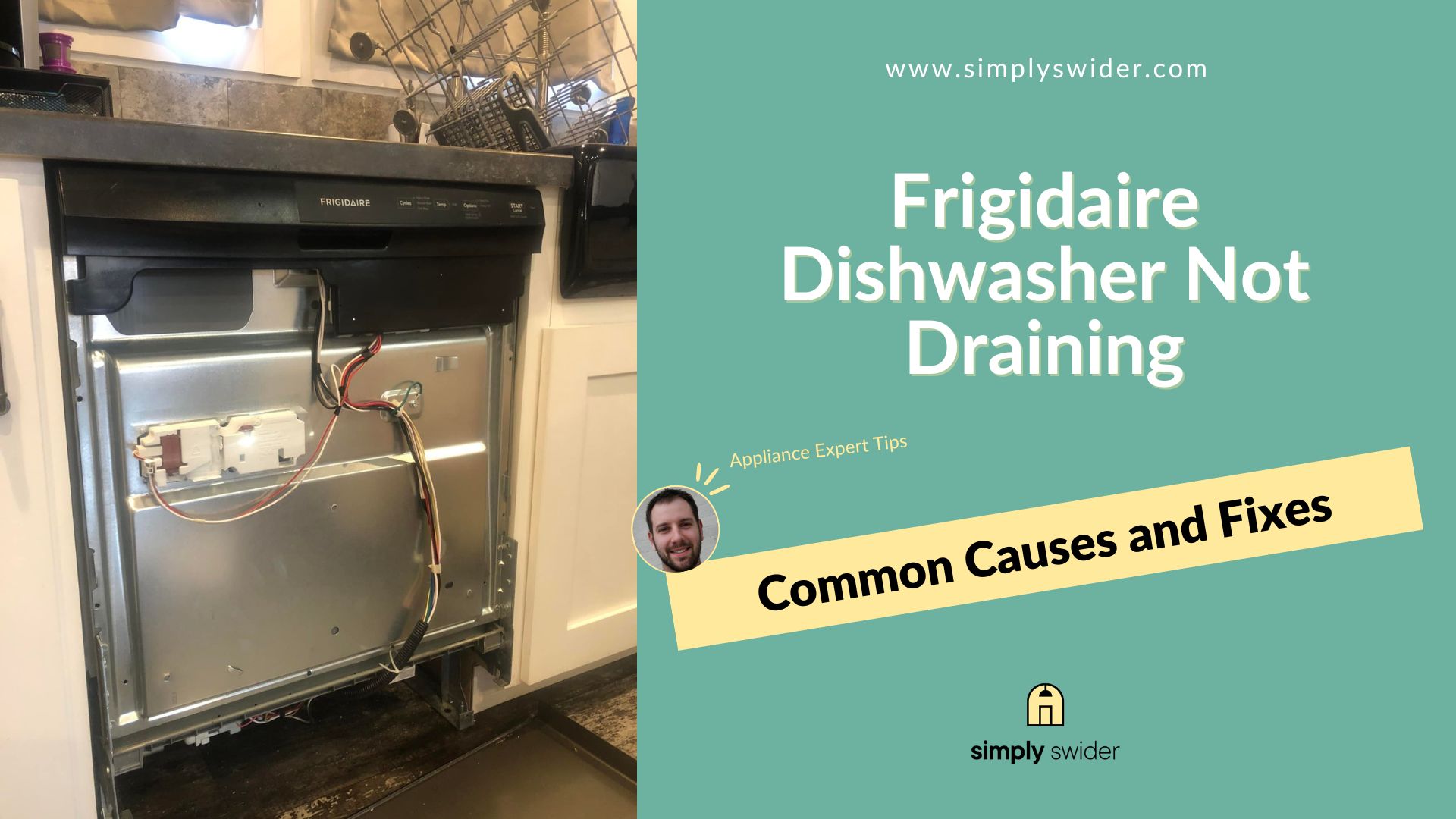Listen up:
I get it. The sight of standing water at the bottom of your Frigidaire dishwasher is maddening, especially when the cycle’s done.
Trust me, I’ve been knee-deep in these issues for years as an appliance technician.
So, here’s the deal:
I’ve teamed up with my go-to expert, Fabian Lloyd, who’s got a knack for troubleshooting these headaches.
Ready?
Let’s dive into why your Frigidaire dishwasher is not draining and how you can get that water out of there.

Table of Contents
Why Is Your Frigidaire Dishwasher Not Draining?
I’ve cracked cases like this more times than I can count. Start with the drain hose; look for kinks or clogs. Then, eyeball the sump filter, examine the drain pump, and scrutinize the garbage disposal setup.
Coming up:
I’ll dive deeper into these four common culprits that could be messing with your dishwasher’s drainage.
So, grab a sponge to clear out the water, unplug the dishwasher, and let’s get to fixing.
Frigidaire Dishwasher Not Draining: 4 Common Causes and Fixes
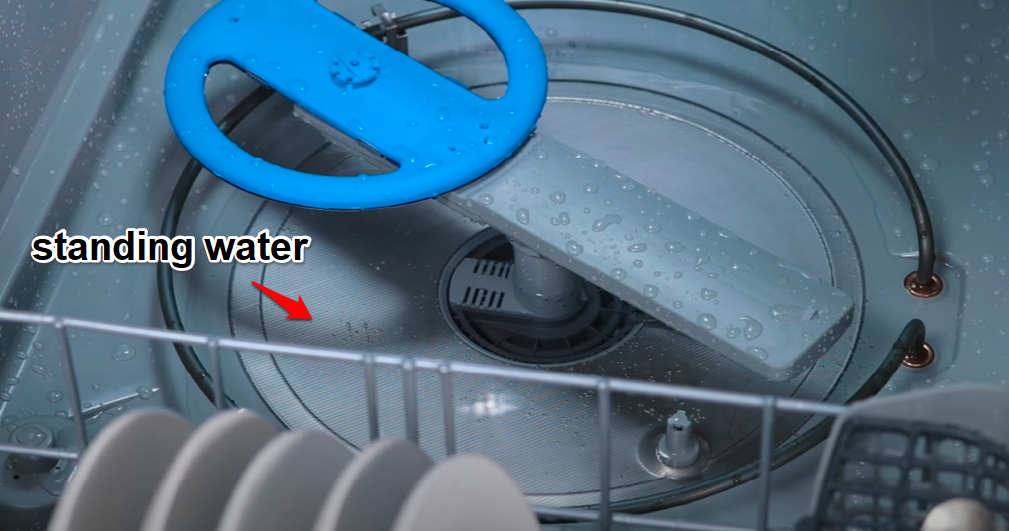
| Commonly Affected Parts | Estimated Cost |
|---|---|
| Drain hose | $10 – $60 |
| Screen filter | $15 – $50 |
| Drain pump | $20 – $130 |
| Garbage disposal | $69 – $210 |
1. Kinked or Clogged Drain Hose
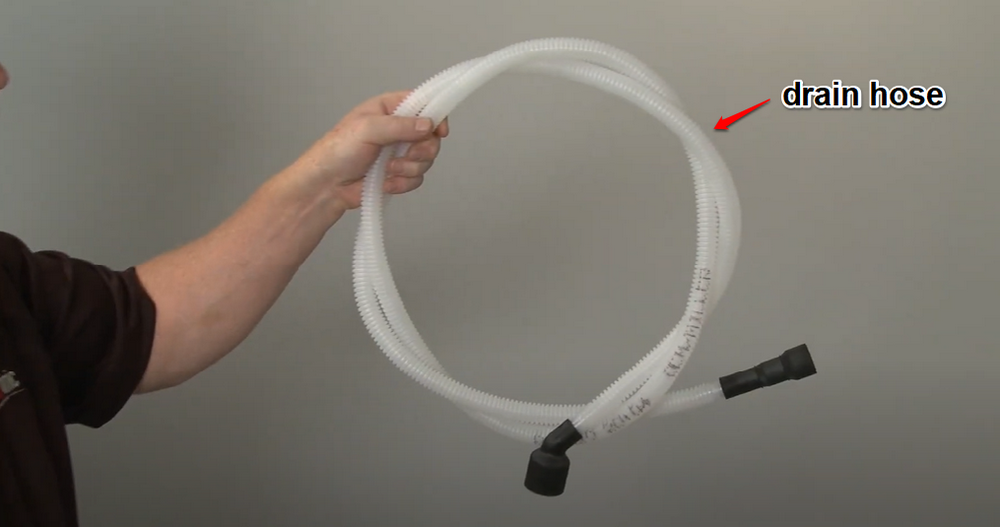
| Part | Drain hose |
| Location | It is attached to the back of the dishwasher and connects to the garbage disposal. |
| Ease of troubleshooting | Easy |
| Cost | $10 – $60 |
| Repairable | Yes – if it is clogged or kinked No – if it is damaged or severely clogged |
Problem:
A participant in this Reddit discussion said, “I’m convinced that 95% of dishwasher problems are just the hoses getting kinked.“
And although this statistic is quite a stretch, I understand the point he’s trying to make.
Specifically:
Draining problems in dishwashers are largely caused by kinked drain hoses.
This is because it requires almost surgical precision to properly install a drain hose behind a dishwasher crimped into a cabinet.
On other occasions:
A clogged drain hose will be the culprit. Fabian comments, “People tend to forget that even the drain hose needs cleaning, leaving food particles to build up in there for ages.”
Identification:
How can you know your drain hose is at fault without unscrewing the dishwasher from its compartment?
The truth is, you can only speculate, and speculations are tricky because many defects share similar symptoms.
For example:
For many of these causes, discovering standing water in the sump area of your dishwasher is an indicator of the defect.
And a kinked or clogged drain hose is not left out.
Take it from this Reddit user:
After constantly noticing standing water at the bottom of their 10-year-old Frigidaire dishwasher, they needed answers quickly.
They also observed that the water went down the drain but backed up into the washer.
At first glance:
My diagnosis was a kinked drain hose.
Fabian was sold on this diagnosis after the user mentioned that the drain hose was unusually long, and pulling the dishwasher out helped drainage.
Furthermore:
You may notice extremely slow drainage when dealing with a clogged hose.
And just like another Reddit user whose Frigidaire dishwasher was clogged, you may find about an inch or two of water left in the tub.
However:
To be certain, you must inspect the hose physically for clogs.
Solution:
The fix is pretty basic. Simply straighten or unclog the drain hose, as the case may be.
Here’s how to go about it:
- Step 1: Unthread the mounting screws fastening the dishwasher to the cabinet.
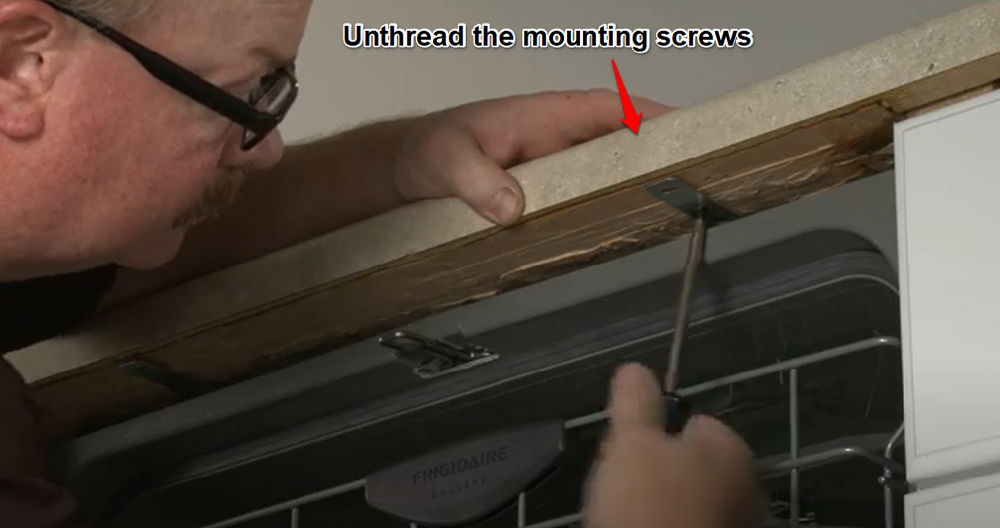
- Step 2: Gently pull the dishwasher out to access the drain hose.
- Step 3: Inspect the drain hose for kinks and creases, then straighten them out carefully.
- Step 4: If you don’t spot any kinks, detach the hose from the dishwasher and garbage disposal.
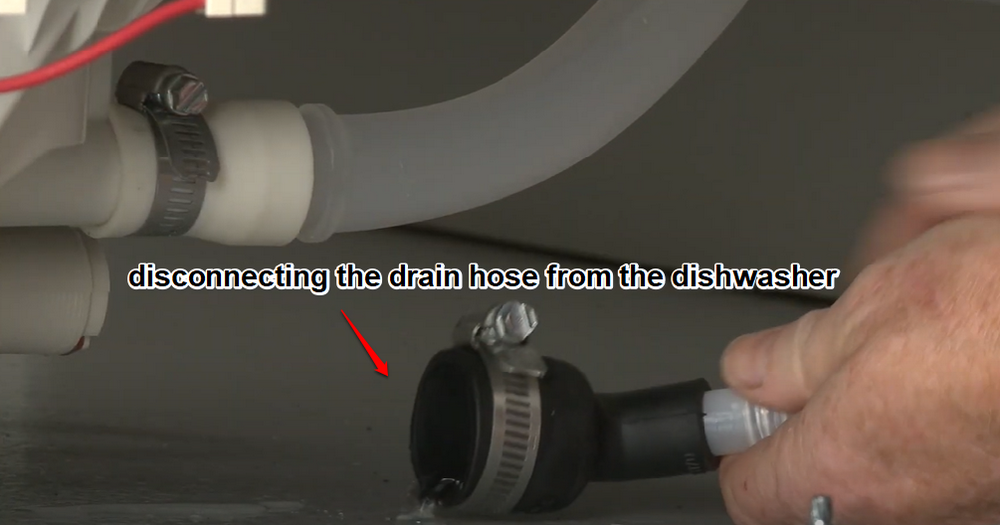
- Step 5: Place a towel or container on the floor to soak up spilled water.
- Step 6: Using a pipe cleaner, meticulously remove accumulated debris from the drain hose.
- Step 7: Replace the hose if the clog is irredeemable. This is completely at your discretion.
- Step 8: Reassemble the washer, plug it in, and run a test cycle.
Fabian adds:
“Remember to check the point where the drain hose connects with the sink or the air gap if you have one.”
“Many times, food chunks and debris accumulate there, preventing your dishwasher from draining efficiently.”
2. Blocked Screen Filter
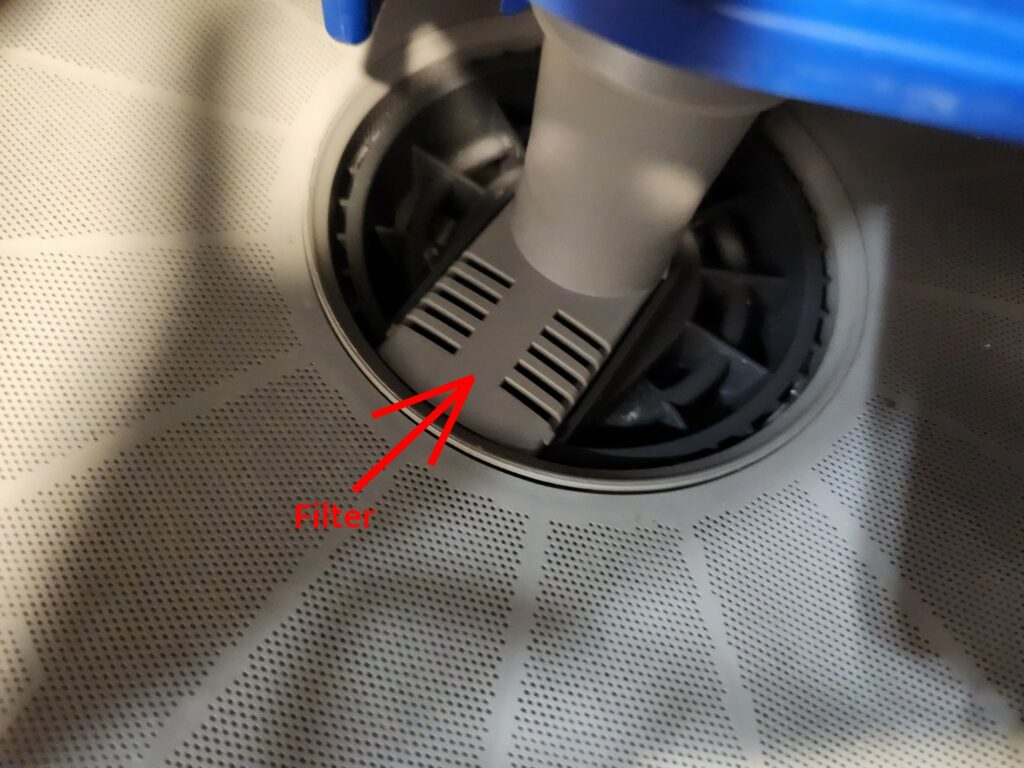
| Part | Screen filter |
| Location | It can be found at the interior bottom of the dishwasher behind the removable bottom rack. |
| Ease of troubleshooting | Easy |
| Cost | $15 – $50 |
| Repairable | Yes – if it is clogged No – if it is irredeemably clogged. |
Problem:
The Frigidaire dishwasher has a coarse and fine screen filter located in the sump area.
These filters collect bits of food and other particles, preventing them from infiltrating the drainage system and causing issues.
Think:
Isn’t it ironic that the part tasked with preventing a drainage failure can cause a drainage failure?
You see:
After catching debris for a while, these filters could become clogged and hinder the flow of water through the drain.
As such, you must figure out whether any or both screens are blocked and troubleshoot them immediately.
Identification:
Having tried everything they could think of, this Reddit user sought help concerning their Frigidaire Gallery dishwasher that was not draining.
They noticed standing water at the bottom after cycles, and their dishes were coming out grimy after a wash.
Eventually:
They realized they had been leaving too many food bits on their plate before chucking them into the dishwasher.
This led Fabian and me to believe strongly that the drain or sump screen filter was blocked with food particles.
Similarly:
Another Reddit user brought up a draining issue in their Frigidaire FGID2466QF5A dishwasher. They also observed the prevalent symptom—standing water at the bottom of the tub.
However:
Another user wrongly claimed that this was normal. To this, Fabian exclaimed, “Nothing is normal about a dishwasher that doesn’t drain completely after a cycle!”
Solution:
So, if you are experiencing any of these symptoms, I’ve got news for you. You have a blocked screen filter.
Here’s what to do:
- Step 1: Detach the removable lower rack.
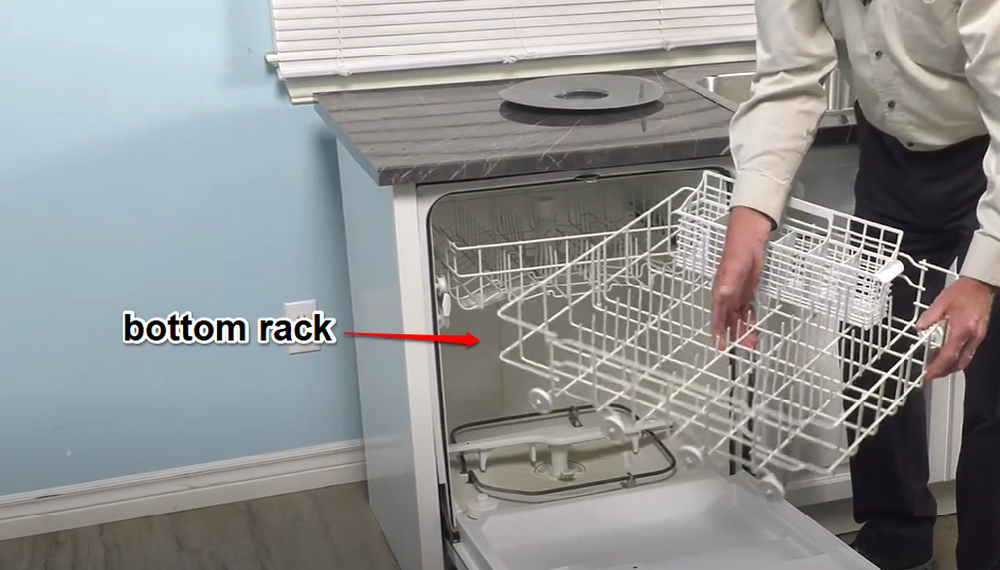
- Step 2: Examine the fine and coarse screen filters in the sump area at the bottom of the dishwasher.
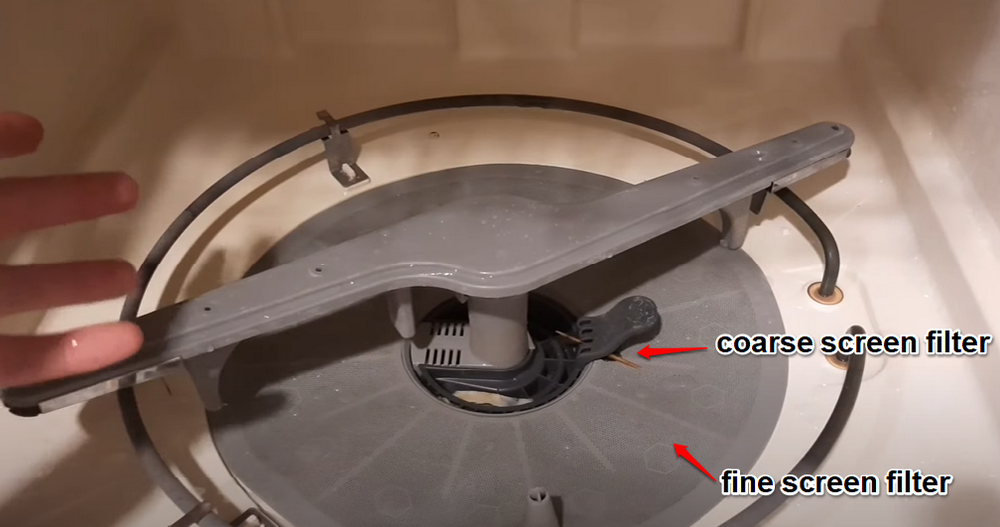
- Step 3: Remove and wash the filters under running water to clear the accumulated debris.
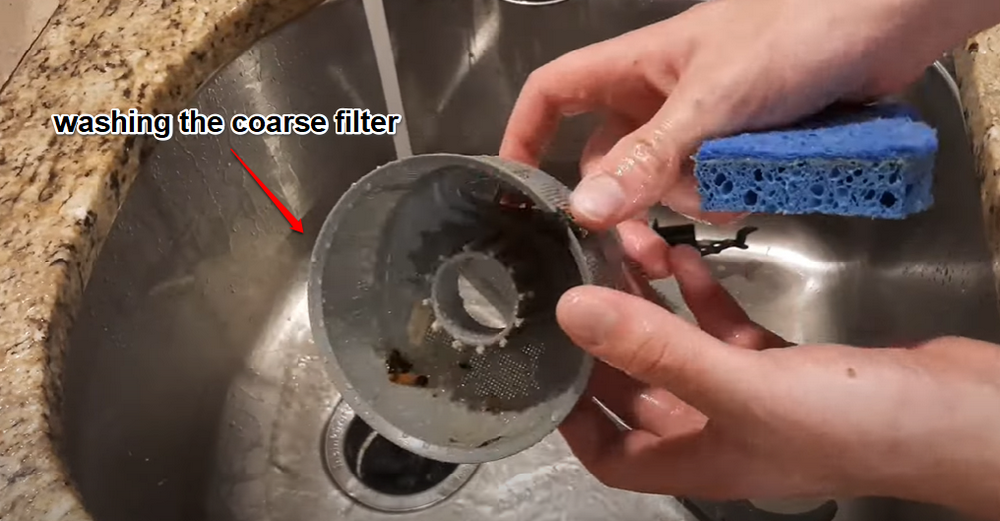
- Step 4: Check the sump area for any leftover debris and clean it out with a wet dishrag or soft sponge.
- Step 5: Inspect the filters for visible damage and replace them if damaged.
- Step 6: Reassemble the dishwasher and run a test cycle to be sure things are smooth.
As a preventive measure:
Fabian urges you to thoroughly rinse off all the leftover food particles from your plates before stacking them in your dishwasher.
“Trust me, it makes a world of difference,” he says.
3. Faulty or Clogged Drain Pump
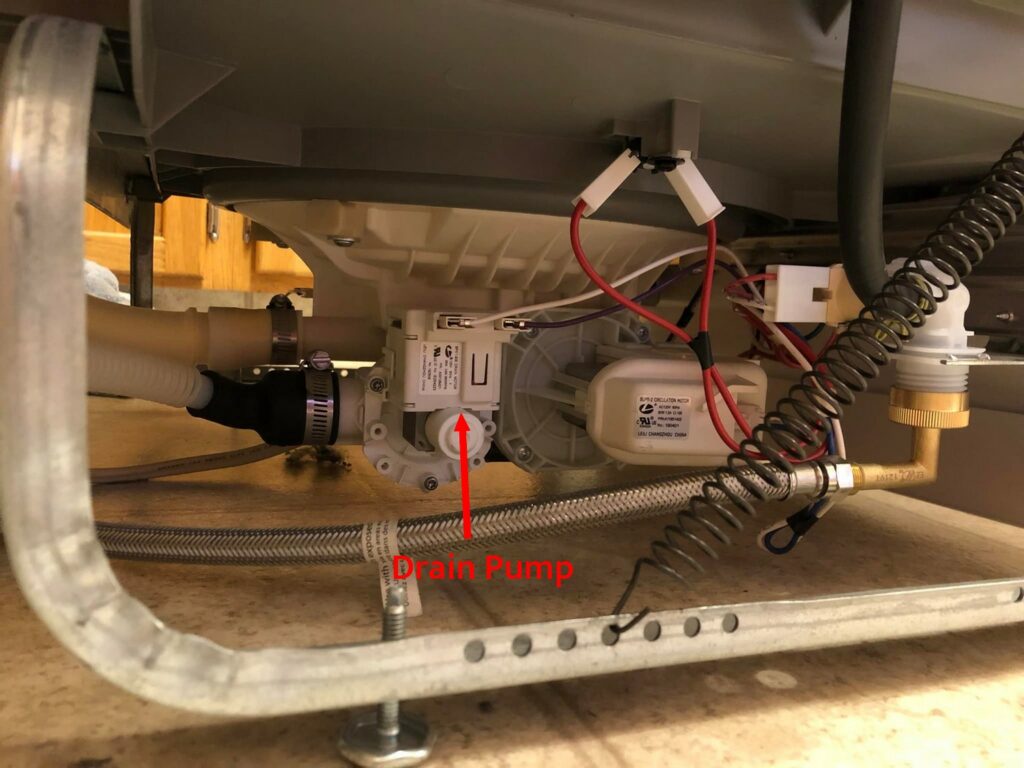
| Part | Drain pump |
| Location | It is situated at the bottom of the dishwasher, behind the access panel. |
| Ease of troubleshooting | Moderate |
| Cost | $20 – $130 |
| Repairable | Yes – if it is blocked No – if it is defective |
Problem:
The next component to check is the core part facilitating your dishwasher’s draining—the drain pump.
Powered by a motor and impeller, the drain pump propels waste water from the dishwasher after a cycle.
Intuitively:
A faulty pump will not effectively drain waste water out of your machine.
Fabian pipes in, “Pieces of food that escaped the filter could easily get lodged in the pump, and let’s not forget about built-up limescale.”
Identification:
If a thumping sound accompanies your Frigidaire dishwasher’s draining problem, you can expect that your drain pump is clogged.
This happened to our Facebook community member, Rick, who shared a video of his dishwasher in action.
Now:
After watching this video, Fabian and I were in agreement on the cause of the issue.
Fabian says, “My best guess is that some glass shards are lodged in the drain pump. You’d be surprised to find out this happens more frequently than you think.”
Indeed:
It does happen a lot. This was corroborated by a participant in a Reddit discussion about a Frigidaire dishwasher that wouldn’t drain.
On the other hand:
If the dishwasher doesn’t run the drain cycle at all, the drain pump is likely damaged and must be replaced.
Solution:
First, you must be sure that you have examined the drain hose and screen filter for clogs before taking on your drain pump.
Like this Reddit user, you don’t want to purchase a replacement pump only to find out your drain hose was merely kinked.
All done?
Great! Here’s how to troubleshoot your clogged or defective dishwasher drain pump:
- Step 1: Unthread the mounting screws, remove the access panel, and locate the drain pump.

- Step 2: Detach the circulation motor cover.
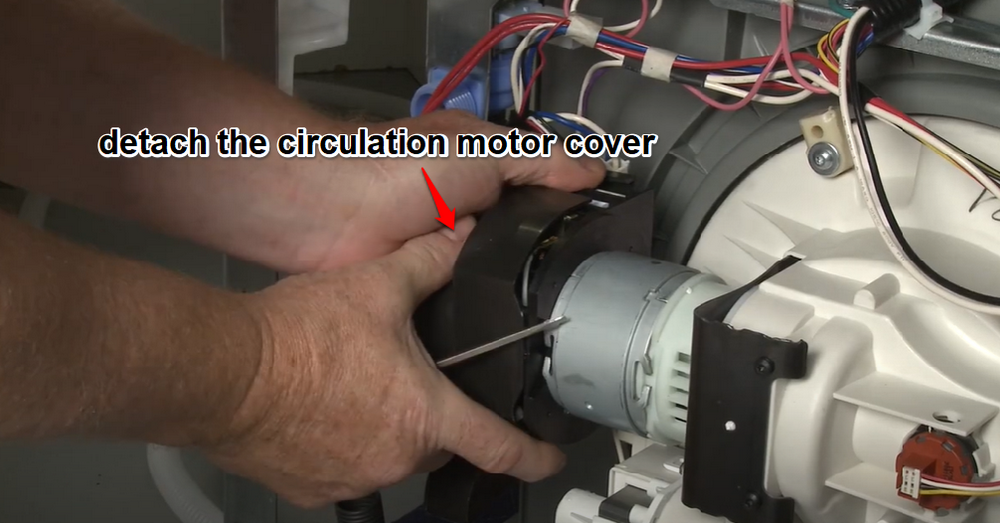
- Step 3: Disconnect the drain pump wiring.

- Step 4: Detach the drain pump from the dishwasher.
- Step 5: Inspect the drain pump for clogs and lodged debris and clear them out with pliers if found.
- Step 6: Spin the drain pump impeller manually, ensuring it spins freely.
- Step 7: Test the drain pump for electrical continuity with a multimeter. If it fails the test, replace it.
- Step 8: Reassemble the dishwasher and run a test cycle.
One more thing:
It is common practice to use vinegar and baking soda to clear limescale build-up from your drain pump. This Reddit user claims it worked for their Frigidaire dishwasher that was having trouble draining.
In my experience:
It’s definitely worth a shot.
4. Improperly Installed or Blocked Garbage Disposal

| Part | Garbage disposal |
| Location | It is a separate unit found under the sink. It is connected to one end of the dishwasher drain hose. |
| Ease of troubleshooting | Easy |
| Cost | $69 – $210 |
| Repairable | Yes – If improperly installed or clogged |
Problem:
Certain errors cannot be overlooked. Just as a user error could stop your dishwasher pods from dissolving, an error when installing your garbage disposal has its consequences.
Unfortunately:
You may already be facing the music. You see, the drainage disposal your dishwasher shares a drain with is usually fitted with a knockout plug in the drain tube.
The idea is that:
When the garbage disposer is connected to the dishwasher, the plug is detached to allow for unrestricted wastewater drainage.
Identification:
So, as suggested in this Reddit discussion, if your garbage disposer was recently installed, you need to check that the knockout plug was removed.
However:
If your garbage disposer wasn’t recently installed, then it is more likely that it is clogged with debris and needs to be cleared.
Solution:
To resolve this issue, remove the knockout plug if it is still attached. Do this using a screwdriver and hammer to push out the plug, then retrieve it with a plier.
It’s as simple as that!
If you’re dealing with a clog, detach the drain hose from the garbage disposal and clean out the fitting where they connect.
Finally, run a cycle to push the leftover debris out.
Models Most Affected
Generally:
Frigidaire manufactures reliable dishwashers; however, some models are more vulnerable to draining issues.
To this end:
Here is an outline of some of these affected dishwasher models. I have also taken the liberty to include the defect that typically spurs this challenge in each specific model.
| Model Number | Model Name | Specific Reason |
|---|---|---|
| FGBD2435 | Frigidaire Gallery Dishwasher | Clogged drain pump |
| FFCD2418US1A | Frigidaire Dishwasher | Blocked garbage disposal |
| FGID2466QF5A | Frigidaire Dishwasher | Blocked screen filter |
| FDBB1940DBO | Frigidaire Dishwasher | Kinked or clogged drain hose |
| FFCD2413US3A | Frigidaire Built-In Dishwasher | Blocked screen filter |
| FBD2400KB12B | Frigidaire Dishwasher | Faulty or clogged drain pump |
| FDB1500LFC2 | Frigidaire Dishwasher | Kinked drain hose |
| FGHD2433KF1 | Frigidaire Dishwasher | Improperly installed garbage disposal |
| GLDB653AB0 | Frigidaire Gallery Dishwasher | Clogged drain hose |
| GSB6400NDC | Frigidaire Aquasurge Dishwasher | Kinked drain hose |
| FFBD2408NS0A | Frigidaire Ultra Quiet Dishwasher | Faulty drain pump |
Conclusion
At the end of the day:
I’ve learned from repairing household appliances that you must have a list of potential causes to examine.
This list should be addressed in order of the most likely to the least likely reason for the appliance failure.
Fortunately:
I have created and organized such a list for you in this article. So, you know to pay attention to these possible faults if your Frigidaire dishwasher won’t drain:
- Kinked or clogged drain hose
- Blocked sump filter
- Faulty or clogged drain pump
- Improperly installed or blocked garbage disposal
Once you’ve gone through them:
Your dishwasher should pick up again, and eventually, any trouble with the drainage will be long forgotten.
If you still have drainage issues or find any repairs challenging, use our “Ask the Expert“ feature to get individualized support.
Finally:
Fabian strongly emphasizes the importance of adhering to a consistent maintenance practice with a popular punchline.
With a cheeky smile, he says, “It is better to be safe than sorry. You don’t want to wait until your Frigidaire dishwasher doesn’t start or runs into another issue to service it.”
Remember:
I’ll be looking out for your additions, experiences, and questions in the comment section below.

